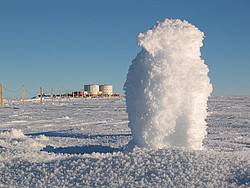
Snow scuplture of a penguin, with the Concordia buildings in the background.
[20050127_32_PenguinSnowed - 1200x1600 - sRGB - 0Mb - 2MPix]
Text and pictures © 1992-2025 Guillaume Dargaud
Last updated on 2021/11/05
This CD contains 360 high resolution Antarctica pictures provided royalty-free.
Want more information about the CD ?
More info and pictures of Glaciology

Snow scuplture of a penguin, with the Concordia buildings in the background.
[20050127_32_PenguinSnowed - 1200x1600 - sRGB - 0Mb - 2MPix]
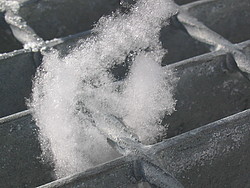
A rare snowflake structured like a very light cottonball.
[20050303_6CottonSnowflake - 1200x1600 - sRGB - 0Mb - 2MPix]
![20051107_042_Crystals - Ice crystals as seen on the accumulation table.
[ Click to go to the page where that image comes from ]](APACD3/20051107_042_Crystals.jpg)
Ice crystals as seen on the accumulation table.
[20051107_042_Crystals - 1200x1600 - sRGB - 1Mb - 2MPix]
![CrystalsIceCave3 - Long exposure in the ice core storage area, using whatever available light there is.
[ Click to download the free wallpaper version of this image ]](APACD3/CrystalsIceCave3.jpg)
Long exposure in the ice core storage area, using whatever available light there is.
[CrystalsIceCave3 - 3564x5430 - AdobeRGB - 1Mb - 19MPix]
![CrystalsIceCave4 - Ice crystals hanging from the roof of an underground storage area.
[ Click to download the free wallpaper version of this image ]](APACD3/CrystalsIceCave4.jpg)
Ice crystals hanging from the roof of an underground storage area.
[CrystalsIceCave4 - 3558x5440 - AdobeRGB - 2Mb - 19MPix]
![CrystalsIceCave5 - Ribs of ice crystals formed on the underground garage ceiling.
[ Click to download the free wallpaper version of this image ]](APACD3/CrystalsIceCave5.jpg)
Ribs of ice crystals formed on the underground garage ceiling.
[CrystalsIceCave5 - 3553x5437 - AdobeRGB - 2Mb - 19MPix]
![EmanueleChangingFilters0 - Many different kinds of analyzes are performed for surface glaciology. Besides the direct samples of snow taken from the ground, there's also several pumps taking in outside air and the few crystals of ice it contains. Those crystals are then sorted by dimensions through an impactor filter, and later analyzed for content. The quantity of crystals in the atmosphere is so low that each pumping session has to run for 3 days non-stop, hoping that the wind won't turn and bring smoke from the station's power plant.
[ Click to go to the page where that image comes from ]](APACD3/EmanueleChangingFilters0.jpg)
Many different kinds of analyzes are performed for surface glaciology. Besides the direct samples of snow taken from the ground, there's also several pumps taking in outside air and the few crystals of ice it contains. Those crystals are then sorted by dimensions through an impactor filter, and later analyzed for content. The quantity of crystals in the atmosphere is so low that each pumping session has to run for 3 days non-stop, hoping that the wind won't turn and bring smoke from the station's power plant.
[EmanueleChangingFilters0 - 3568x5403 - AdobeRGB - 2Mb - 19MPix]
![EmanueleChangingFilters1 - Emanuele changing on of the filters on the roof of his shelter.
[ Click to go to the page where that image comes from ]](APACD3/EmanueleChangingFilters1.jpg)
Emanuele changing on of the filters on the roof of his shelter.
[EmanueleChangingFilters1 - 3555x5390 - AdobeRGB - 1Mb - 19MPix]
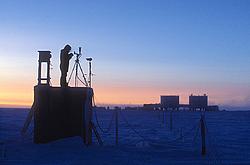
Changing filters on the roof of the glaciology shelter.
[EmanueleChangingFilters4 - 3555x5390 - AdobeRGB - 2Mb - 19MPix]
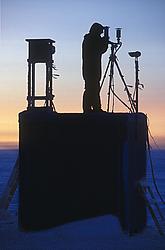
Changing filters on the roof of the glaciology shelter.
[EmanueleChangingFilters5 - 5390x3555 - AdobeRGB - 1Mb - 19MPix]
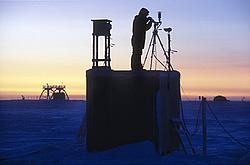
Changing filters on the roof of the glaciology shelter.
[EmanueleChangingFilters6 - 3555x5390 - AdobeRGB - 1Mb - 19MPix]

Changing filters on the roof of the glaciology shelter.
[EmanueleChangingFilters8 - 3568x5403 - AdobeRGB - 1Mb - 19MPix]
![EmanueleCheckingCrystals2 - Visual inspection of freshly deposited snow crystals.
[ Click to go to the page where that image comes from ]](APACD3/EmanueleCheckingCrystals2.jpg)
Visual inspection of freshly deposited snow crystals.
[EmanueleCheckingCrystals2 - 5392x3560 - AdobeRGB - 1Mb - 19MPix]
![EmanueleCollectingSamples0 - Night sampling in a windstorm. Up on the high antarctic plateau the wind is rare and not very fast, but enough to drop the visibility to a few meters and the windchill to a terrifying -110°C.
[ Click to go to the page where that image comes from ]](APACD3/EmanueleCollectingSamples0.jpg)
Night sampling in a windstorm. Up on the high antarctic plateau the wind is rare and not very fast, but enough to drop the visibility to a few meters and the windchill to a terrifying -110°C.
[EmanueleCollectingSamples0 - 5643x3658 - AdobeRGB - 4Mb - 21MPix]
![EmanueleCollectingSamples10 - Snow samples are collected inside small vials, sealed, and then analyzed in the lab on the ion chromatograph.
[ Click to go to the page where that image comes from ]](APACD3/EmanueleCollectingSamples10.jpg)
Snow samples are collected inside small vials, sealed, and then analyzed in the lab on the ion chromatograph.
[EmanueleCollectingSamples10 - 3590x5394 - AdobeRGB - 1Mb - 19MPix]
![EmanueleCollectingSamples3 - Getting ready for a snow sampling session in the winter twilight, right at the pole marker.
[ Click to download the free wallpaper version of this image ]](APACD3/EmanueleCollectingSamples3.jpg)
Getting ready for a snow sampling session in the winter twilight, right at the pole marker.
[EmanueleCollectingSamples3 - 3553x5413 - AdobeRGB - 2Mb - 19MPix]
![EmanueleCollectingSamples4 - Collecting snow destined to be melted and analyzed.
[ Click to go to the page where that image comes from ]](APACD3/EmanueleCollectingSamples4.jpg)
Collecting snow destined to be melted and analyzed.
[EmanueleCollectingSamples4 - 3560x5423 - AdobeRGB - 1Mb - 19MPix]
![EmanueleCollectingSamples9 - Winter snow sampling garb: plastic gloves on top of pile gloves to avoid contamination, face mask against freezing lungs and serious 'bellylamp' to find the way.
[ Click to download the free wallpaper version of this image ]](APACD3/EmanueleCollectingSamples9.jpg)
Winter snow sampling garb: plastic gloves on top of pile gloves to avoid contamination, face mask against freezing lungs and serious 'bellylamp' to find the way.
[EmanueleCollectingSamples9 - 3656x5631 - AdobeRGB - 3Mb - 21MPix]
![FrozenEmanuele - Winter portrait of Emanuele under his face mask during the long walk. Temperature: -75°C by the time we got back.
[ Click to go to the page where that image comes from ]](APACD3/FrozenEmanuele.jpg)
Winter portrait of Emanuele under his face mask during the long walk. Temperature: -75°C by the time we got back.
[FrozenEmanuele - 5388x3560 - AdobeRGB - 1Mb - 19MPix]
![IceCoreBox2 - The ice cores as well as their wrappings have detailed information on them: location, depth and time of extraction, up and down directions, estimated size of the missing parts on top and bottom, etc...
[ Click to go to the page where that image comes from ]](APACD3/IceCoreBox2.jpg)
The ice cores as well as their wrappings have detailed information on them: location, depth and time of extraction, up and down directions, estimated size of the missing parts on top and bottom, etc...
[IceCoreBox2 - 3572x5450 - AdobeRGB - 2Mb - 19MPix]
![IceCoreBoxes - Putting the cores into cold storage boxes after wrapping them up with extraction information written on both cores and bags.
[ Click to go to the page where that image comes from ]](APACD3/IceCoreBoxes.jpg)
Putting the cores into cold storage boxes after wrapping them up with extraction information written on both cores and bags.
[IceCoreBoxes - 5410x3614 - AdobeRGB - 2Mb - 20MPix]
![IceCoreDiameterMeasure3 - Measuring the diameter of the ice core to check on drill wear.
[ Click to go to the page where that image comes from ]](APACD3/IceCoreDiameterMeasure3.jpg)
Measuring the diameter of the ice core to check on drill wear.
[IceCoreDiameterMeasure3 - 5389x3623 - AdobeRGB - 1Mb - 20MPix]
![IceCoreDisplay - Display of several ice cores worth a couple thousand years of climatic data. At those depths, one meter of ice can hold 500 years of information.
[ Click to go to the page where that image comes from ]](APACD3/IceCoreDisplay.jpg)
Display of several ice cores worth a couple thousand years of climatic data. At those depths, one meter of ice can hold 500 years of information.
[IceCoreDisplay - 3608x5432 - AdobeRGB - 2Mb - 20MPix]
![IceCores - A scientist cutting up and examining ice cores in the 'cold lab'.
[ Click to go to the page where that image comes from ]](APACD3/IceCores.jpg)
A scientist cutting up and examining ice cores in the 'cold lab'.
[IceCores - 3608x5407 - AdobeRGB - 2Mb - 20MPix]
![IceCoreSlice1 - An ice core, split lengthwise so as to get access to the clean center.
[ Click to go to the page where that image comes from ]](APACD3/IceCoreSlice1.jpg)
An ice core, split lengthwise so as to get access to the clean center.
[IceCoreSlice1 - 3619x5379 - AdobeRGB - 2Mb - 19MPix]
![IceCoreSlice2 - An ice core, split lengthwise so as to get access to the clean center. The bigger part stays in Dome C for reference while the slice is sent to european laboratories for detailed analysis.
[ Click to go to the page where that image comes from ]](APACD3/IceCoreSlice2.jpg)
An ice core, split lengthwise so as to get access to the clean center. The bigger part stays in Dome C for reference while the slice is sent to european laboratories for detailed analysis.
[IceCoreSlice2 - 3602x5410 - AdobeRGB - 2Mb - 19MPix]
![IceCoreStorage2 - Cores waiting to be processed are placed in shelves at the entrance of the cold lab.
[ Click to go to the page where that image comes from ]](APACD3/IceCoreStorage2.jpg)
Cores waiting to be processed are placed in shelves at the entrance of the cold lab.
[IceCoreStorage2 - 3572x5369 - AdobeRGB - 1Mb - 19MPix]
![IceCrystals2 - Ice crystals forming outdoors on the top a tower.
[ Click to go to the page where that image comes from ]](APACD3/IceCrystals2.jpg)
Ice crystals forming outdoors on the top a tower.
[IceCrystals2 - 5388x3549 - AdobeRGB - 2Mb - 19MPix]
![IceCrystals3 - Some of the very delicate ice crystals to be found in a storage cave. If you as much as touch them, they dissolve into ice dust.
[ Click to go to the page where that image comes from ]](APACD3/IceCrystals3.jpg)
Some of the very delicate ice crystals to be found in a storage cave. If you as much as touch them, they dissolve into ice dust.
[IceCrystals3 - 3549x5370 - AdobeRGB - 2Mb - 19MPix]
![IceCrystals4 - Large crystal hanging from the ceiling of an underground storage area.
[ Click to go to the page where that image comes from ]](APACD3/IceCrystals4.jpg)
Large crystal hanging from the ceiling of an underground storage area.
[IceCrystals4 - 3563x5438 - AdobeRGB - 2Mb - 19MPix]
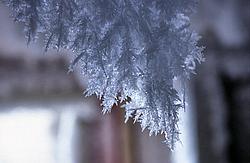
Large crystal hanging from the ceiling of an underground storage area.
[IceCrystals5 - 3552x5442 - AdobeRGB - 2Mb - 19MPix]
![IceCrystalsWindow - Window frost. Windows of the Concordia buildings are made with a triple outer pane, 20cm of space, and another double pane. Most times in winter some frost would form in the middle space.
[ Click to download the free wallpaper version of this image ]](APACD3/IceCrystalsWindow.jpg)
Window frost. Windows of the Concordia buildings are made with a triple outer pane, 20cm of space, and another double pane. Most times in winter some frost would form in the middle space.
[IceCrystalsWindow - 3558x5439 - AdobeRGB - 3Mb - 19MPix]
![MeasuringPoles2 - The height of snow is measured precisely because the yearly snow accumulation on the high plateau is only a few centimeters, and most of the snow falls in winter while in summer it tends to sublimate. Actually the snow doesn't fall in the common sense of the term as much as it just 'appears' in a solid state condensation process directly on exposed surfaces. The lidar helps determine how much snow is falling in the form of very thin ice crystals.
[ Click to go to the page where that image comes from ]](APACD3/MeasuringPoles2.jpg)
The height of snow is measured precisely because the yearly snow accumulation on the high plateau is only a few centimeters, and most of the snow falls in winter while in summer it tends to sublimate. Actually the snow doesn't fall in the common sense of the term as much as it just 'appears' in a solid state condensation process directly on exposed surfaces. The lidar helps determine how much snow is falling in the form of very thin ice crystals.
[MeasuringPoles2 - 3560x5388 - AdobeRGB - 1Mb - 19MPix]
![PlaceMarkers - One in a series of several surface markers used to regularly measure the movement of the ice. Dome C is defined as the top of the local ice, but it's so flat that it's easier to define it as the place from which the ice flows in every direction, which is more interesting to deep drilling glaciologists. The station is visible far away on the horizon from this reference pole used yearly by specialized GPS equipment to pinpoint to flow of ice to within a few cm a year horizontally.
[ Click to go to the page where that image comes from ]](APACD3/PlaceMarkers.jpg)
One in a series of several surface markers used to regularly measure the movement of the ice. Dome C is defined as the top of the local ice, but it's so flat that it's easier to define it as the place from which the ice flows in every direction, which is more interesting to deep drilling glaciologists. The station is visible far away on the horizon from this reference pole used yearly by specialized GPS equipment to pinpoint to flow of ice to within a few cm a year horizontally.
[PlaceMarkers - 5388x3560 - AdobeRGB - 2Mb - 19MPix]
![RestingOnSnow - Taking a break on the snow after a non-stop 4 hour walk on snow at sub -70°C temperatures.
[ Click to go to the page where that image comes from ]](APACD3/RestingOnSnow.jpg)
Taking a break on the snow after a non-stop 4 hour walk on snow at sub -70°C temperatures.
[RestingOnSnow - 3553x5388 - AdobeRGB - 1Mb - 19MPix]
![SnowCrystals1 - Surface snow as seen on a glaciology collection plate. On this image and the following ones, many different shapes can be seen: needles, bullets, balls, flakes, cylinders...
[ Click to go to the page where that image comes from ]](APACD3/SnowCrystals1.jpg)
Surface snow as seen on a glaciology collection plate. On this image and the following ones, many different shapes can be seen: needles, bullets, balls, flakes, cylinders...
[SnowCrystals1 - 3547x5423 - AdobeRGB - 2Mb - 19MPix]
![SnowCrystals3 - Snow crystals after being exposed to the sun for a while.
[ Click to go to the page where that image comes from ]](APACD3/SnowCrystals3.jpg)
Snow crystals after being exposed to the sun for a while.
[SnowCrystals3 - 5412x3562 - AdobeRGB - 3Mb - 19MPix]
![SnowCrystals6 - Even more snow crystals. There's an official list of about 4000 ice crystal shapes!
[ Click to download the free wallpaper version of this image ]](APACD3/SnowCrystals6.jpg)
Even more snow crystals. There's an official list of about 4000 ice crystal shapes!
[SnowCrystals6 - 5403x3559 - AdobeRGB - 2Mb - 19MPix]
![TalosDome-AshLayerInCore - A glaciologist showing the ash layer found in a recent ice-core.
[ Click to go to the page where that image comes from ]](APACD3/TalosDome-AshLayerInCore.jpg)
A glaciologist showing the ash layer found in a recent ice-core.
[TalosDome-AshLayerInCore - 3560x5400 - AdobeRGB - 1Mb - 19MPix]
![ThinSnowWall1 - A thin wall of snow letting sunlight through in order to show yearly layers.
[ Click to go to the page where that image comes from ]](APACD3/ThinSnowWall1.jpg)
A thin wall of snow letting sunlight through in order to show yearly layers.
[ThinSnowWall1 - 3559x5435 - AdobeRGB - 2Mb - 19MPix]
![ThinSnowWall2 - Yearly deposits of snow are no more than 10~20cm thick on the surface.
[ Click to go to the page where that image comes from ]](APACD3/ThinSnowWall2.jpg)
Yearly deposits of snow are no more than 10~20cm thick on the surface.
[ThinSnowWall2 - 5420x3555 - AdobeRGB - 2Mb - 19MPix]